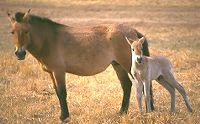 Of all the dangers that threaten the sustained existence of the Przewalski population in the wild a possible crossbreeding of takhi and domestic Mongolian horses, will have the most hazardous effect. Even the tiniest resource of water is been sought after by herdsmen and their cattle and horses. Everywhere lurks the danger of hybridization. Domestic horses in Mongolia roam unheeded and unfenced. In contrast with all domestic horses including the Mongolian, which have 64 chromosomes, Przewalski horses have two more: 66 chromosomes. A cross between a takhi and a domestic horse produces fertile offspring, albeit at the expense of the unique wild characteristics of the Przewalski horse. For example, in a hybrid the typical upright manes are no longer present.
Of all the dangers that threaten the sustained existence of the Przewalski population in the wild a possible crossbreeding of takhi and domestic Mongolian horses, will have the most hazardous effect. Even the tiniest resource of water is been sought after by herdsmen and their cattle and horses. Everywhere lurks the danger of hybridization. Domestic horses in Mongolia roam unheeded and unfenced. In contrast with all domestic horses including the Mongolian, which have 64 chromosomes, Przewalski horses have two more: 66 chromosomes. A cross between a takhi and a domestic horse produces fertile offspring, albeit at the expense of the unique wild characteristics of the Przewalski horse. For example, in a hybrid the typical upright manes are no longer present.
But what action should we take to prevent genetic pollution?
- The free roaming Przewalski harems run little risk of hybridisation or genetic pollution, for their leading stallions do not tolerate any rivals near their mares, be it another Przewalski horse or domestic one. Other takhi stallions are being chased away and domestic ones will be approached with explicit demeanour. Therefore, the chance of domestic stallions siring wild mares is a very little one. However, Przewalski males without a harem are a high risk factor. Until now the bachelors stay close to the family groups in the Park, but as the population increases they might move to the edges of the Park near the buffer zone where domestic horses are being kept. Hybridisation of takhi stallions and domestic mares in the buffer zone is likely to turn into grave problems.
- The protective measures that are being implemented at Hustai National Park are by far the most effective in the whole of Mongolia. However, the lack of fences makes the implementation very difficult. Every day at sunset all over Mongolia herdsmen herd their cattle, sheep and goats back to their round felt tents or gers, to offer them protection against predators. However, horses and camels are being kept unattended all year round. During periods of drought and food shortage these animals themselves will look for water and high-protein food. The already overgrazed buffer zone has little to offer them, but inside the protected Hustai National Park such resources are plentiful. Therefore, sustainable protection of the Park and its inhabitants, the unique takhi population can only seriously be effectuated in cooperation with local people. Thanks to such cooperation a number of measures could be effectuated. In the buffer zone area some extra wells for the benefit of the local livestock were built. Also the old tradition of “otors”, has been re-established. Hired cattlemen, so-called arats, have been assigned with the task of bringing the herdmens’ horses in the period from October till March to other areas away from the direct border with the National Park. This enlightens the stress of domestic horses on the Park in times of drought or food shortage. Experience taught us that sustainable protection will only be possible through adequate park management and protection at its borders (sufficient wardens and rangers). Continuation of financial support to the park staff will remain a top priority for the Dutch Foundation in order to guarantee the continued protection of the National Park.
- Research aimed at the Przewalski horses must continue. Every ranger is responsible for one or more free roaming Przewalski groups. Recording of the horses’ whereabouts, special occasions (births, deaths, group composition, injuries etc.) are daily routine for them and the “takhi-biologist”. The genetics of the founders of the Hustai takhi population is recorded. With the present DNA technology the genetic diversity of the population can be examined at each moment.
